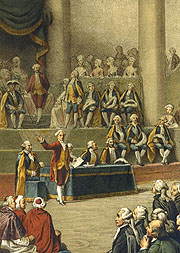 The deepening financial crisis in France at the end of the eighteenth century led the king to appoint a series of finance ministers. Two of these Charles Alexandre de Calonne and Jacques Necker suggested that the required reforms would need the assent of the French nation, or at least those represented by the Estates-General.
The deepening financial crisis in France at the end of the eighteenth century led the king to appoint a series of finance ministers. Two of these Charles Alexandre de Calonne and Jacques Necker suggested that the required reforms would need the assent of the French nation, or at least those represented by the Estates-General.
This body, similar to a parliament, had not assembled since 1614, as a succession of French monarchs exercised absolute rule. The Estates-General consisted of three groups: the First Estate represented the clergy; the Second Estate represented the aristocracy; and the Third Estate represented (in theory) the remaining 97% of the nation, although they were only voted for by the wealthier of the bourgeoisie. This latter group demanded double representation to prevent the first two estates voting together and effectively silencing them, in order that the Estates-General go ahead the king acquiesced.
The three estates convened at Versailles on the 5th May 1789 with much pomp and ceremony. Yet, within the days the Third Estate discovered that their double representation was a sham and the assembly reached an impasse. A breakaway by the Third Estate in June 1789 to form a National Assembly was a major factor in bringing about revolution in France and ending hopes of peaceful reform.
If you want to learn more about the Estates-General and the events that followed from an eighteenth century perspective, you can download François Mignet's History of the French Revolution from 1789 to 1814 (1824) from Project Gutenberg.
Customised search for historical information
6 May 2008
On this (yester)day in history: French Estates-General meet, 1789
Subscribe to:
Post Comments (Atom)















0 comments:
Post a Comment